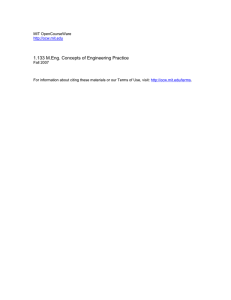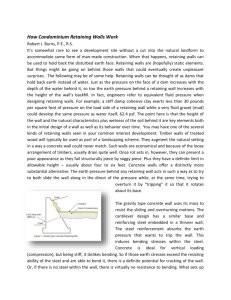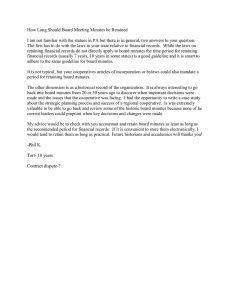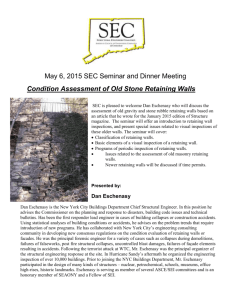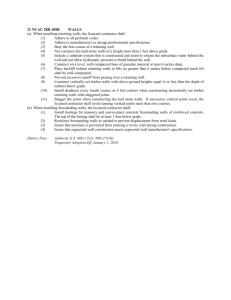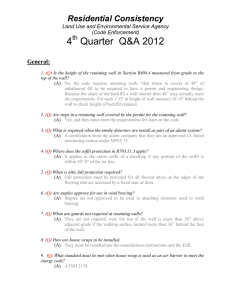retaining walls
advertisement
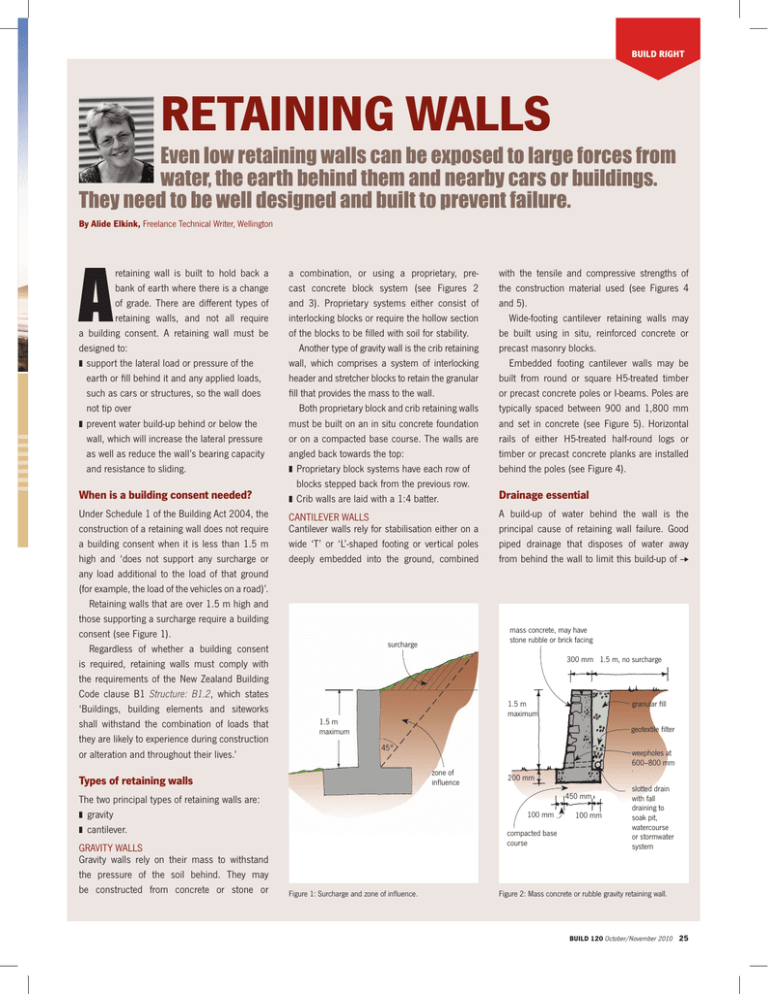
BUILD RIGHT RETAINING WALLS Even low retaining walls can be exposed to large forces from water, the earth behind them and nearby cars or buildings. They need to be well designed and built to prevent failure. By Alide Elkink, Freelance Technical Writer, Wellington A retaining wall is built to hold back a bank of earth where there is a change of grade. There are different types of retaining walls, and not all require a building consent. A retaining wall must be designed to: ❚❚ support the lateral load or pressure of the earth or fill behind it and any applied loads, such as cars or structures, so the wall does not tip over ❚❚ prevent water build-up behind or below the wall, which will increase the lateral pressure as well as reduce the wall’s bearing capacity and resistance to sliding. When is a building consent needed? Under Schedule 1 of the Building Act 2004, the construction of a retaining wall does not require a building consent when it is less than 1.5 m high and ‘does not support any surcharge or any load additional to the load of that ground (for example, the load of the vehicles on a road)’. Retaining walls that are over 1.5 m high and those supporting a surcharge require a building consent (see Figure 1). Regardless of whether a building consent is required, retaining walls must comply with the requirements of the New Zealand Building Code clause B1 Structure: B1.2, which states ‘Buildings, building elements and siteworks shall withstand the combination of loads that they are likely to experience during construction or alteration and throughout their lives.’ a combination, or using a proprietary, precast concrete block system (see Figures 2 and 3). Proprietary systems either consist of interlocking blocks or require the hollow section of the blocks to be filled with soil for stability. Another type of gravity wall is the crib retaining wall, which comprises a system of interlocking header and stretcher blocks to retain the granular fill that provides the mass to the wall. Both proprietary block and crib retaining walls must be built on an in situ concrete foundation or on a compacted base course. The walls are angled back towards the top: ❚❚ Proprietary block systems have each row of blocks stepped back from the previous row. ❚❚ Crib walls are laid with a 1:4 batter. with the tensile and compressive strengths of the construction material used (see Figures 4 and 5). Wide-footing cantilever retaining walls may be built using in situ, reinforced concrete or precast masonry blocks. Embedded footing cantilever walls may be built from round or square H5-treated timber or precast concrete poles or I-beams. Poles are typically spaced between 900 and 1,800 mm and set in concrete (see Figure 5). Horizontal rails of either H5-treated half-round logs or timber or precast concrete planks are installed behind the poles (see Figure 4). CANTILEVER WALLS Cantilever walls rely for stabilisation either on a wide ‘T’ or ‘L’-shaped footing or vertical poles deeply embedded into the ground, combined A build-up of water behind the wall is the principal cause of retaining wall failure. Good piped drainage that disposes of water away from behind the wall to limit this build-up of mass concrete, may have stone rubble or brick facing surcharge 300 mm 1.5 m, no surcharge 1.5 m maximum 1.5 m maximum granular fill geotextile filter 45° weepholes at 600–800 mm zone of influence Types of retaining walls 200 mm 450 mm The two principal types of retaining walls are: ❚❚ gravity ❚❚ cantilever. GRAVITY WALLS Gravity walls rely on their mass to withstand the pressure of the soil behind. They may be constructed from concrete or stone or Drainage essential 100 mm compacted base course Figure 1: Surcharge and zone of influence. 100 mm slotted drain with fall draining to soak pit, watercourse or stormwater system Figure 2: Mass concrete or rubble gravity retaining wall. BUILD 120 October/November 2010 25 pressure is essential, except for walls that retain free-draining sand. The drainage system should consist of granu­ lar free-draining gravel placed immediately behind the wall for a minimum width of 300 mm and for the full height of the wall. A perforated or slotted drainage pipe, pro­ tected with a filter cloth to prevent it from being clogged by silt, must be installed behind the base of the wall to collect and remove water, which is then drained to a stormwater system. Weepholes should also be provided in the base of the wall. Designing retaining walls When a building consent is required, the wall must be specifically designed by a registered engineer. Concrete masonry retaining walls can precast concrete or timber crib wall laid to a batter of 1:4 topsoil be designed in accordance with the following New Zealand standards (but it is prudent to have the design checked and inspected by a structural engineer): ❚❚ NZS 4210:2001 Masonry construction: Materials and workmanship. ❚❚ NZS 4229:1999 Concrete masonry buildings not requiring specific engineering design. ❚❚ NZS 4230:2004 Design of reinforced concrete masonry structures. Manufacturers of some proprietary retaining wall systems, particularly crib walls, have preengineered design tables that may be used without the need to engage an engineer. Some other design considerations include: ❚❚ the type of soil that is to be supported – suitable soils include non-cohesive granular topsoil height in accordance with manufacturer’s requirements filter cloth excavated face geotextile filter header vertical reinforcing 60 mm cover to filled side granular fill drainage metal granular fill geotextile filter 150 pole at 1:10 batter at 900 mm centres maximum ground retained to manufacturer’s requirements ground weepholes granular fill rails or half rounds horizontal reinforcing stretcher granular fill 200 mm concrete blockwork with fully grouted cells to NZS 4229 soils (gravel, sand, rock) and cohesive soils (stiff clay); unsuitable soils include very soft clays, peat and made-up ground or topsoil ❚❚ the location of the wall – it must have sufficient space to be constructed so that it does not cross a boundary and it must be set back from a bank or sloping ground in front of the wall ❚❚ a safety barrier – under Building Code clause F4 Safety from falling, a barrier is required where people can fall more than 1 m from the top of the retaining wall, but this only applies where it can reasonably be expected that there will be people. If the wall is located where people are not generally expected to be, a barrier is not required (Determination No. 99/012 (12 October 1999)). geotextile filter drain with fall draining to soak pit, watercourse or stormwater system 17 MPa concrete drain with fall draining to soak pit, watercourse or stormwater system concrete foundation laid to correct batter Figure 3: Proprietary concrete or timber crib walling. drain with fall draining to soak pit, watercourse or stormwater system 75 mm cover H5-treated poles poles embedded to manufacturer’s requirements Figure 4: Example of cantilever concrete block retaining wall with ‘L’-shaped footing. Figure 5: Cantilevered timber pole retaining wall. 26 BUILD 120 October/November 2010 WAT1
